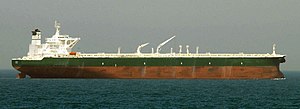Tanker (ship): Difference between revisions
| Line 42: | Line 42: | ||
[[Category:Ship types]] |
[[Category:Ship types]] |
||
[[Category:Commercial item transport and distribution]] |
[[Category:Commercial item transport and distribution]] |
||
[http:www.olympicvessels.com] |
[http://http:www.olympicvessels.com Olympic Vessels] |
||
== External links == |
== External links == |
||
Revision as of 16:23, 2 May 2007

A tanker is a ship designed to transport liquids in bulk.
Tankers can range in size of capacity from several hundred tons, which includes vessels for servicing small harbours and coastal settlements, to several hundred thousand tons, for long-range haulage. A wide range of products are carried by tankers, including:
- hydrocarbon products such as oil, LPG, and LNG
- chemicals, such as ammonia, chlorine, and styrene monomer
- fresh water
- wine
Different products require different handling and transport. Thus special types of tankers have been built, such as "chemical tankers" and "oil tankers". "LNG carriers," as they are typically known, are a relatively rare tanker designed to carry liquefied natural gas.
Among oil tankers, supertankers are designed for transporting oil around the Horn of Africa from the Middle East. The floating storage and offloading unit (FSO) Knock Nevis, formerly the ULCC "Jahre Viking," is the largest vessel in the world. The supertanker is 458 metres (1504 feet) in length and 69 m (226 ft) wide.
Supertankers are the only method for transporting large quantities of oil apart from pipeline transport. However such tankers can create environmental disasters from oil spills if a shipping accident causes a sinking close to coastal regions. See Exxon Valdez, Braer, Prestige, Torrey Canyon, Erika for examples.
Size
Tankers used for liquid fuels are classified according to their capacity.
In 1954 Shell Oil developed the afra system (average freight rate assessment) for fiscal reasons. Tankers were divided in groups of different sizes. To make it an independent instrument, Shell consulted London Tanker Brokers’ Panel (LTBP). At first, they divided the groups as General Purpose for tankers under 25,000 deadweight tonnage (dwt); Medium Range for ships between 25,000 and 45,000 dwt; and Large Range for the then enormous ships that were larger then 45,000 dwt. The ships became larger during the 1970s, and the list was extended, where the tons are long tons:[1]
- 10,000 – 24,999 dwt – General Purpose tanker
- 25,000 – 44,999 dwt – Medium Range tanker
- 45,000 – 79,999 dwt – LR1 (Large Range 1)
- 80,000 – 159,999 dwt – LR2 (Large Range 2)
- 160,000 - 319,999 dwt - VLCC (Very Large Crude Carrier)
- 320,000 - 549,999 dwt - ULCC (Ultra Large Crude Carrier)
The following groups are used for use on the oil market:
- 10,000 - 60,000 dwt - Product tanker (Seawaymax, Handymax)
- 60,000 - 80,000 dwt - Panamax
- 80,000 - 120,000 dwt - Aframax
- 120,000 - 200,000 dwt - Suezmax
- 200,000 - 315,000 dwt - VLCC (Malaccamax)
- 320,000 - 550,000 dwt - ULCC
References
External links
- [1] Olympic Vessels's free gate to the maritime markets, buy or sell your vessels]
- [2] Auke Visser's supertankers information page.
- ship-photos.de: Categorized ship photos.
- [3] Poten & Partners: A collection of articles relating to tankers
- [4] Pictures of wine tankers
